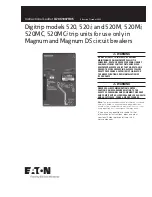
11
Instructional Leaflet
IL70C1037H05
Effective October 2009
Digitrip models 520, 520i; and 520M, 520Mi,
520MC, 520MCi trip units for use only in
Magnum and Magnum DS circuit breakers
eaton corporation
www.eaton.com
Section 2: General description of Magnum
circuit breakers
Gtntral
Magnum circuit breakers are tripped automatically on overload fault
current conditions by the combined action of three components:
1.
The sensors, which measure the current level.
2.
The Digitrip trip unit, which provides a tripping signal to the trip
actuator when current and time delay settings are exceeded.
3.
The low-energy trip actuator, which actually trips the
circuit breaker.
Figurt 6
shows this tripping circuit for a typical Magnum circuit
breaker. This arrangement provides a very flexible system, covering
a wide range of tripping characteristics described by the time-current
curves referenced in Section 9.
Figurt 6. Tripping Circuio fNr a Typical Magnum Brtaktr (Paroial)
The automatic overload and short-circuit tripping characteristics for a
specific circuit breaker are determined by the ratings of the installed
current sensors with a matching rating plug and the selected
functional protection settings. Specific setting instructions are
provided in Section 4.
When the functional protection settings are exceeded, the Digitrip
unit supplies a trip signal to the trip actuator. As a result, all tripping
operations initiated by the protection functions of the Digitrip trip
unit are performed by its internal circuitry. There is no mechanical
or direct magnetic action between the primary current and the
mechanical tripping parts of the breaker, and external control power
is not required.
m
WARNING
IMPROPER POLARITY CONNECTIONS ON THE TRIP ACTUATOR COIL WILL
DEFEAT THE OVERLOAD AND SHORT CIRCUIT PROTECTION, WHICH COULD
RESULT IN PERSONAL INJURY. OBSERVE POLARITY MARKINGS ON THE
TRIP ACTUATOR LEADS AND CONNECT THEM PROPERLY, USING THE
INSTRUCTIONS PROVIDED.
Top End
Bottom End
Digitrip
Polarity
Marks
Low Energy Trip Actuator
Black
ST+
ST–
LNw-tntrgy orip acouaoNr
The mechanical force required to initiate the tripping action of
a Magnum circuit breaker is provided by a special low-energy
trip actuator. The trip actuator is located under the black molded
platform on which the Digitrip unit is supported. The trip actuator
contains a permanent magnet assembly, moving and stationary
core assemblies, a spring, and a coil. Nominal coil resistance is
22 ohms and the black lead is positive. The circuit breaker
mechanism assembly contains a mechanism-actuated reset lever
and a trip lever to actuate the tripping action of the circuit breaker.
When the trip actuator is reset by the operating mechanism, the
moving core assembly is held in readiness against the force of the
compressed spring by the permanent magnet. When a tripping
action is initiated, the low-energy trip actuator coil receives a tripping
pulse from the Digitrip unit. This pulse overcomes the holding effect
of the permanent magnet, and the moving core is released to trigger
the tripping operation via the trip lever.
GrNund faulo prNotcoiNn
General
When the Digitrip 520 family includes ground fault protection
features, the distribution system characteristics (for example,
system grounding, number of sources, number and location of
ground points, and the like) must be considered along with the
manner and location in which the circuit breaker is applied to the
system. These elements are discussed in this section.
The Digitrip 520 uses three modes of sensing to detect ground
fault currents: residual, source ground, and zero sequence (see
Tablt 3
). Magnum circuit breakers can accommodate all three
types, except for four-pole breakers. The breaker secondary contact
inputs B-6, B-7 are used to configure the breaker cell positions for
the three schemes. No jumper from B-6 to B-7 programs the unit
for a residual ground fault scheme, while a jumper from B-6 to B-7
programs the trip unit for either a source ground or zero sequence
configuration. If present, this jumper resides on the stationary side
of the switchgear assembly. In all three schemes, the proper current
sensor input is required on the external sensor input terminals B-4,
B-5 of the breaker secondary contacts.
Tablt 3. Digiorip Stnsing MNdts
Ground (Earth)
Fault Sensing
Method
Breaker
Secondary
Contacts Req’d.
Applicable
Breakers
Figure
Reference
Digitrip GF
Sensing
Element Used
Residual
No jumper
Three- or
four-pole
7, 8, 10, 14
Element R
5
Source ground
Jumper B6 to B7
Three-pole only
12
Element R
4
Zero sequence
Jumper B6 to B7
Three-pole only
13
Element R
4
Note:
N
This information applies to trip units with ground.
Residual sensing
Residual sensing is the standard mode of ground fault sensing in
Magnum circuit breakers. This mode uses one current sensor on
each phase conductor and one on the neutral for a four-wire system
(shown in
Figurt 7
and
Figurt 8
). If the system neutral is grounded,
but no phase to neutral loads are used, the Digitrip 520 family of
units includes all of the components necessary for ground fault
protection. This mode of sensing vectorially sums the outputs of
the three or four individual current sensors. For separately mounted
neutrals, as long as the vectorial sum is zero, then no ground fault
exists. The neutral sensor must have characteristics and a ratio
that are identical to the three internally mounted phase current
sensors. Available types of neutral sensors are shown in
Figurt 9
.
Residual ground fault sensing features are adaptable to main and
feeder breaker applications. Available ground fault pickup settings
employing residual sensing are given in
Tablt 4
.
Figurt 10
shows a
four-pole breaker with residual ground fault sensing.



































